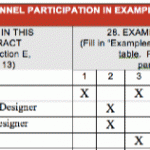
Recently, the New York Times conducted an interesting experiment. They  wanted to figure out if their choice of font had any impact on whether readers believed statements they made. What they found is going to blow your mind.
wanted to figure out if their choice of font had any impact on whether readers believed statements they made. What they found is going to blow your mind.
The Experiment
To answer this question, they set up an online survey, providing readers with a number of statements and asking whether they agreed with them. The quiz was titled, “Are You An Optimist Or A Pessimist?”
Here is what the readers didn’t know. Each of the statements was true and different readers received the statements in different fonts.
They received thousands of responses, enough to make the results statistically significant.
The Fonts
The fonts they tested included:
- Helvetica
- Trebuchet
- Georgia
- Computer Modern
- Comic Sans
- Baskerville
Baskerville Won Hands Down
They found that, quite surprisingly, the use of font did play a role in whether readers believed the statements. And by far, people were more likely to believe statements written in Baskerville.
Look at these charts from the New York Times website.
People are more likely to agree with and less likely to disagree with text written in Baskerville. While this experiment wasn’t conducted in a strictly scientific way, this is a huge discovery.
Many proposal managers use fonts like Helvetica, Trebuchet, and Georgia. It appears this is a big mistake. Helvetica, for one, got some of the worst results.
You can read about the entire experiment and get the full results over at the New York Times website. I encourage you to check it out.
If you want to download the Baskerville font, you can get it at this link (But take a look at the picture below first).








I wonder why they didn’t include something as common as Times New Roman? Do you suppose TNR would rate pretty close to Baskerville? I hope so, since that’s what we use in our proposals.
Trish,
One very unscientific study suggested that Georgia fared better than Times New Roman. Baskerville had better results than Georgia in the New York Times study.
I am also disappointed that Times New Roman was not included in the study. It seems like an obvious choice to test.
Many of our clients require 12pt Times New Roman font. I try to keep most of our marketing materials in line with this to cut down on formatting time. But my go-to accent font (for covers, presentations, headers, etc.) is Arial Narrow (sometimes in Bold). It is simple and sleek – and luckily comes with everyone’s computer software so it does not get turned into courier!
Carrie,
There are certainly many RFPs that dictate Times New Roman or Arial. And in those cases, you certainly don’t want to be seen as unresponsive.
Just wondering why this article isn’t written in Baskerville…
Susan,
I don’t think baskerville is a font commonly found on the web. Anyway, I’m much to lazy to change my wordpress theme now! 😛
I agree with the comments re RFP requirements to use TNR, typically 12 point but occasionally 10 point. This requirement facilitates computer-aided scoring, which is used by a number of organizations.
It is interesting to note what the New York Times has done. In 2003, the front page and mains news sections of the NYT received a “gentle typographical face-lift.”
“In place of a miscellany of headline typefaces that have accumulated in its columns over the years, the newspaper is settling on a single family, Cheltenham, in roman and italic versions and various light and bold weights.”
It is interested that the NYT poll did not include Cheltenham.
While I’m all for science, I’m not sure this experiment proves anything (other than that you shouldn’t use Comic Sans for your proposals, which hopefully you already knew).
Reuben,
Like I mention in the article, the science is questionable but the results are interesting.
Actually, the science is already proven and has been for years. This experiment was interesting only because it proved that the font comprehension and status is the same with online as found previously for print.
See the book: “Type and Layout Are You Communicating or Just Making Pretty Shapes” by Colin Wheildon, reprinted in 2005
This book both documents previous tests on fonts, but covers the consequences of the wrong font (Times New Roman is fine).
The greater issue is comprehension IMHO. Sans Serif fonts will reduce the comprehension of printed matter by as much as 40 percent. In fact, when publishers WANT to reduce comprehension, they may chose to use sans serif fonts on purpose. But when you want high comprehension, you need a serif font without embellishment, and that’s where Baskerville, New Times Roman, etc. excel.
Great! I’ll check it out.
Interesting. I have always preferred a sans serif font, like Arial. Much easier for me to read.
Kim,
You have to consider the differences in reading on a screen vs. on paper.
Interesting study and discussion. I am concerned, though, that the data does not seem to warrant such a major conclusion. Looking at the numbers, the difference between 16,300 and 15,900 is less than 3%, correct? Unless I am missing something, the graphic illustration is an example of selective chart making to exaggerate a point of view. Happens all the time and is often misleading. Thanks for the article. Sherman Aronson AIA
Hi Sherman,
They address that concern in the New York Times article.